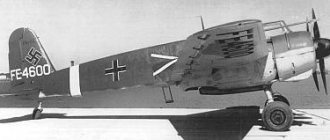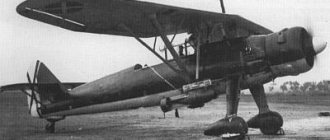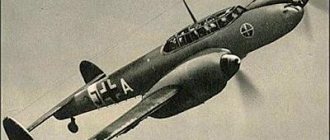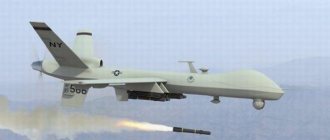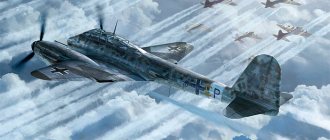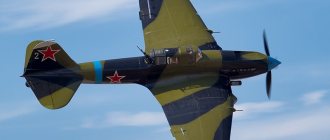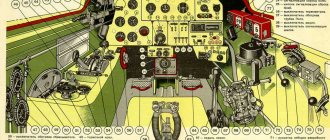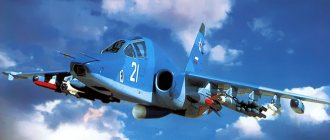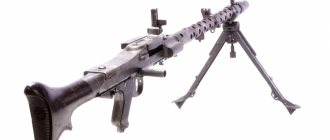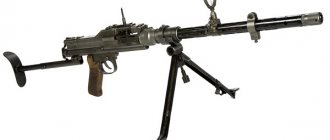“Henschel Hs.123 - The first dive bomber of the German Luftwaffe - the “bomber of the first stage”, which served exactly until the Ju-87 dive bomber was completed. History of the creation and combat use of the aircraft"
The Henschel Hs.123 dive bomber bears little resemblance to the standard of beauty
The history of the Henschel Hs.123 bomber
In September 1933, the German Air Ministry announced a competition to create a dive bomber. The competition was two-stage: at the first stage it was necessary “just yesterday” to create a biplane, from which high performance was not required, except, perhaps, the speed of development. And the second step is to create a truly new and modern aircraft. Accordingly, the vehicle of the first stage was a kind of “plug” for the Air Force until something truly interesting was done.
Henschel Hs.123 was precisely the “first stage” dive bomber. It was created in parallel with its competitor - Fi-98, from .
The first prototype of the dive bomber (Hs.123V1) took to the skies for the first time on April 1, 1935. In terms of its parameters, it showed complete superiority over the Fi-98 prototype, was shown to government officials in May, and in August 1935 was tested at the Rechlin test site. After modifications, the aircraft was put into mass production in the summer of 1936. Adopted by the Luftwaffe in November 1936.
Drawing of the Henschel Hs.123 dive bomber
Production of the Hs.123 took place in Schönefeld and Johannishtal, and at the AGO Flygtsoigwerk in Oschersleben. Until September 1938, 260 aircraft were manufactured. Exported to Spain and China.
Eastern front
After a holiday in the Balkans, in April 1941 the unit entered into hostilities with the Soviet Union on the Southern Front. It joined the newly formed 1st Attack Squadron and again confirmed the high effectiveness of the Hs 123 in supporting ground forces. Armed with four SC 50 bombs, a twin 20 mm MG FF cannon or underwing containers each containing 92 SC 2 fragmentation bombs, with a fuel tank under the fuselage, the Hs 123 proved so useful and reliable that even at the end of 1943 proposals to resume their production.
During the Second World War, Hs 123s operated in the northern direction, then took part in the battles of Bryansk, Vyazma, and in the battle of Moscow. In May 1942, Hs 123s fought in the Crimea, then took part in the battles near Kharkov. In the summer of 1943, Hs 123 fought on the Kursk Bulge.
During heavy rains, when other aircraft could not take off from the airfields that had turned into a swamp, the Hs 123 did so without difficulty, it was enough just to remove the landing gear fairings.
The lack of new aircraft and the war, which was steadily collecting its toll, led to the fact that units with the Hs 123 ended their days in mid-1944; the remaining aircraft were assembled into the II Group of the 2nd Attack Squadron.
| Photo | Description |
| Scheme Hs 123 A-1 | |
| Hs 123 V5 prototype | |
| Hs 123 on the Eastern Front |
Design of the Henschel Hs.123 bomber and main modifications
The Hs.123 dive bomber was a single-column sesquiplane with an all-metal semi-monocoque fuselage, oval in cross-section, and fabric-covered wings. The double-spar upper wing was attached to the fuselage by N-shaped struts. The lower wing was single-spar.
The landing gear is tricycle, non-retractable, with a freely oriented tail wheel. The main landing gear is covered with fairings.
The power plant consisted of a piston 9-cylinder star-shaped air-cooled BMW.132 engine.
The armament consisted of 2 7.92 mm MG-17 machine guns. Two 20-mm MG-FF cannons could be mounted on the underwing mounts. The bomb load consisted of a 250 kg bomb under the fuselage and 4 50 kg bombs under the wing. Instead of a bomb, an additional 130 liter fuel tank could be suspended under the fuselage.
Henschel Hs.123 dive bomber
Aircraft modifications:
- Hs.123V1 - the first prototype, with a BMW.132A-3 engine producing 650 hp. and a closed NASA hood. First flight April 1, 1935.
- Hs.123V2 is the second prototype, with a smaller diameter hood and 18 small fairings over the cylinder heads. Equipped with 2 synchronized MG-17 machine guns.
- Hs.123V3 - the third prototype, with a two-bladed Hamilton-Standard variable-pitch propeller.
- Hs.123V4 is the standard for the series. It featured a reinforced center section and a braced stabilizer. First flight in August 1935.
- Hs.123V5 - prototype of Hs.123B. It was distinguished by a BMW.132J engine with a power of 910 hp.
- Hs.123V6 - prototype of the Hs.123C attack aircraft. It featured two additional MG-17 machine guns in the lower wing, an enclosed cockpit, and an armored headrest.
- Hs.123V7 - prototype with BMW.132K engine producing 960 hp.
- Hs.123A-0 - pre-production. A small series was released in July 1936.
- Hs.123A-1 - the first production version, with a BMW.132Dc engine with direct fuel injection. Produced since August 1936.
- Hs.123B-1 - modernized. It was distinguished by a BMW.132K engine and metal wing trim.
Ground force support
In 1937, Ju 87s began to replace the Hs 123s in the Stukagruppe, and the latter were transferred to direct support of the ground forces - they equipped two of the proposed five air units. There was controversy within the Luftwaffe over the relative merits of specializing as a dive bomber or a close support aircraft for ground forces. The dive bomber supporters won. The Ju 87 was also assigned to ground forces, signaling the end of production of the Hs 123. Two prototypes were built: the Hs 123B, powered by a BMW 132K engine with an extended hood, and the Hs 123C, which featured additional machine guns under the wings, an armored headrest and a sliding canopy, which became installed on combat Hs 123A.
At the end of 1938, after the end of the Sudeten crisis, air units in direct support of ground forces were officially disbanded. However, one 10th attack air group survived and became part of the 2nd training squadron as the II assault group (squadron) (II (Schlacht) / LG 2). In September 1939, it was the only first-line unit with the Hs 123; all other aircraft of this type were transferred to training units.
II (Schlacht)/LG 2 was in the forefront of the air units that carried out the attacks on Poland on September 1, 1939, which marked the beginning of World War II. For ten days, Hs 123s, armed with 50-kilogram underwing bombs and MG 17 machine guns, attacked Polish cavalry brigades from low altitude. However, it was not the weapons that were more effective, but the terrible noise of the BMW radial engines, which frightened the horses, which threw the troops into chaos no less than the bombing. The effectiveness of the Hs 123 in the Polish lightning campaign was so great that plans to re-equip II (Schlacht)/LG 2 were immediately cancelled.
The next target of the named air unit was Belgium, where from May 10, 1940 it supported the 6th Army from the air. The first task was to prevent Belgian sappers from destroying the bridge over the Albert Canal. Passing through Luxembourg and the Ardennes, the Hs 123s soon found themselves in France, and by 21 May, reaching Cambrai, they proved to be the most advanced unit of the Luftwaffe. After the occupation of France, II (Schlacht)/LG 2 was transferred to Germany to be re-equipped with the Bf 109E, but by then the Hs 123s had gained a legendary reputation for their combat survivability, so the group was only partially equipped with Messerschmitts.
Characteristics of Hs.123A-1
A country:GermanyType:Dive bomberYear of issue:1935Crew:1 personEngine:1x BMW-132Dc with 880 hpMaximum speed:340 km/hPractical ceiling:9000 mRange of flight:855 kmEmpty weight:1500 kgMaximum take-off weight:2220 kg (normal takeoff)Wingspan:10.5 mLength:8.3 mHeight:3.2 mWing area:24.8 sq.m.Weapons:2x 7.92 mm machine guns (defensive weapons), up to 450 kg bomb load
Content
- 1 Design and development 1.1 Production
- 2.1 Before World War II
- 3.1 Subsequent designs
Links[edit]
- Jump up ↑
Green 1970, pp. 150. - ↑ Air International,
August 1978, p. 73. - ↑
Bishop, Chris (2014), Encyclopedia of World War II Weapons, Amber Books Ltd, p. 337, ISBN 978-1782741671 - Fredricksen, John S. (2001), International Warbirds: An Illustrated Guide to the World's Military Aircraft, 1914-2000, ABC-CLIO, p. 171, ISBN 978-1576073643
- ^ ab Lepage, Jean-Denis G.G. (2009), Aircraft of the Luftwaffe, 1935–1945: An Illustrated Guide, McFarland & Co, p. 113, ISBN 978-0786439379
- ^ a b Smith, John Richard; Kay, Anthony L. (2002), German Aircraft of the Second World War (Revised ed.), Putnam Aeronautical Books, p. 163
- Weal, Chris (2003), Air Force Schlachtgruppen, Osprey, pp. 8-9, ISBN 978-1841766089
- ^ a b c d Fitzsimmons 1967, p. 1373.
- "达州故事:" 宕渠好儿郎 "郑少愚" .每日头条 - 卢贵清
(in Chinese). Retrieved November 23, 2022. Chinese Air Force Henschel HS-123 from the 15th Squadron (No. 1508) ... - Weal 1997, p. 5.
- Weal 1997, pp. 4-6.
- ↑
brother of Manfred von Richthofen, "The Red Baron" - Jump up
↑ Taylor 1969, p. 172. - ↑
Winchester 2004, pp. 130-131. - Jump up
↑ Winchester 2004, p. 131. - Smith and Kay 1972, p. 321.
Operators[edit]
republic of china
- Republic of China Air Force - operated 12 aircraft as dive bombers.
Nazi Germany
- Luftwaffe
Spanish state
- The Spanish Air Force acquired the remaining aircraft of the Condor Legion and ordered 11 more aircraft from Germany. On the Eastern Front, Escuadrilla Azul
(15
Spanische Staffel
/VIII
Fliegerkorps
) from JG 27 based at Vitebsk used Hs 123s along with II units. (Schl.) / LG 2.
Legacy[edit]
The Henschel Hs 123 showed that a slow but tough and reliable aircraft could be effective in ground attack. Despite its dated appearance, the Hs 123 proved useful on every World War II battlefield on which it fought. [14]
It is known that Hs 123 did not survive.
Subsequent designs[edit]
The success of the Hs 123 in the Spanish Civil War led the RLM to request a successor aircraft. At this point in history, the exact role of aircraft in supporting the army was still being worked out. It was perhaps the first dedicated attack aircraft to serve in a close air support role in the niche between the tactical bomber and the dive bomber. The Henschel Hs 129 was chosen as a successor.
Bibliography[edit]
- Eden, Paul and Soph Moeng, eds. The Complete Encyclopedia of World Aviation
. London: Amber Books, 2002. ISBN 0-7607-3432-1. - Fitzsimmons, Bernard, ed. "HS 123, Henschel." The Illustrated Encyclopedia of 20th Century Weapons and War
. New York: Columbia House, 1967. - Franco, Lucas Molina. Henschel HS 123 (Perfiles Aeronáuticos 2: La Máquina y la Historia)
(in Spanish with English subtitles). Valladolid, Spain: Quiron Ediciones, 2006. ISBN 84-87314-61-9. - Green, William. Combat Aircraft of World War II, Volume Nine: Bombers
. London: Macdonald & Co. (Publishers), 1968 (Fourth Impression, 1972). ISBN 0-356-01491-6. - Green, William. Combat aircraft of the Third Reich
. London: Macdonald and Jane's Publishers, 1970 (Fourth Impression, 1979). ISBN 0-356-02382-6. - Gunston, Bill. An Illustrated Guide to German, Italian and Japanese Fighters of World War II: The Major Fighters and Attack Aircraft of the Axis Powers
. New York: Arco Publishing, 1980. ISBN 0-668-05093-4. - Gunston, Bill. Encyclopedia of combat aviation of the worlds"
. New York: Chartwell Books, 1976. - Gunston, Bill and Tony Wood. Hitler's Luftwaffe
. London: Salamander Books, 1977. ISBN 0-86101-005-1. - Hoefling, Rudolf. Henschel Hs 123: Die Geschichte eines legendären Schlachtflugzeuges (Flugzeug Profile 42)
(in German). Stengelheim, Germany: Unitec Medienvertrieb, 2004. - Ledvoch, Janusz. Henschel Hs 123 (Wydawnictwo Militaria 4)
(in Polish with English captions. Warsaw, Poland: Wydawnictwo Militaria, 1995. ISBN 83-86209-30-5. - "Udet's Legacy... Henschel HS 123." Air International
, Vol. 15, No. 2, August 1978, pp. 72–79. Bromley, UK: Fine Scroll. - Shepard, Christopher. German aircraft from World War II with color photographs
. Edinburgh: Sidgwick and Jackson, 1975. ISBN 0-283-98179-2. - Smith Jr and Anthony Kay. German aviation during World War II
. London: Putnam & Company, 1972. ISBN 0-370-00024-2. - Taylor, John W.R. "Henschel Hs 123." Combat Aircraft of the World from 1909 to the Present
. New York: G. P. Putnam's Sons, 1969. ISBN 0-425-03633-2. - Wil, John. "Eastern Front, Schlachtflieger". Wings of Glory, Vol.
7 . London: Aerospace Publishing, 1997. ISBN 1-880588-23-4. - Winchester, Jim. "Henschel Hs 123." Airplanes of World War II: Aviation Facts.
Kent, UK: Grange Books, 2004. ISBN 1-84013-639-1.
